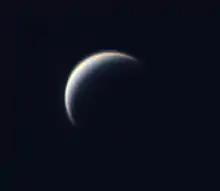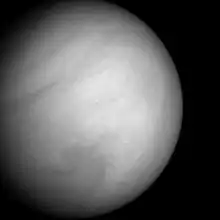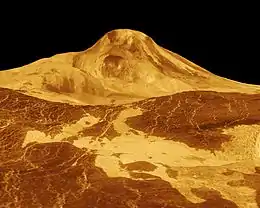List of missions to Venus
This is a list of the 42 (and counting) space missions to the planet Venus. Missions to Venus constitute part of the exploration of Venus.
| Decade |
|
|---|---|
| 1960s | 18 |
| 1970s | 11 |
| 1980s | 8 |
| 1990s | 1 |
| 2000s | 2 |
| 2010s | 5 |
| 2020s | 1 |
List
As of 2018, the Soviet Union, United States, European Space Agency and Japan have conducted missions to Venus.
- Mission Type Legend
- Mission to VenusGravity assist, destination elsewhere
| Spacecraft | Launch date[1] | Operator | Mission | Outcome | Remarks | Carrier rocket[2] |
|---|---|---|---|---|---|---|
| Tyazhely Sputnik (1VA No.1) |
4 February 1961 | OKB-1 |
Impactor[3] | Launch failure | Power transformer failure, upper stage failed to ignite, never left LEO[3] | Molniya |
| Venera 1 (1VA No.2) |
12 February 1961 | OKB-1 |
Impactor[3] | Spacecraft failure | Communications failure. Flyby on 19 May 1961 at less than 100,000 kilometres (62,000 mi); no data returned | Molniya |
| Mariner 1 (P-37) |
22 July 1962 | NASA |
Flyby | Launch failure | Failed to orbit; destroyed by range safety following guidance failure[4] | Atlas-LV3 Agena-B |
| 2MV-1 No.1 | 25 August 1962 | OKB-1 |
Lander | Launch failure | Premature upper stage cutoff due to ullage motor malfunction; never left LEO[4] | Molniya |
| Mariner 2 (P-38) |
27 August 1962 | NASA |
Flyby | Successful | Flyby on 14 December 1962 | Atlas-LV3 Agena-B |
| 2MV-1 No.2 | 1 September 1962 | OKB-1 |
Lander | Launch failure | Upper stage fuel valve failed to open, resulting in failure to ignite; never left LEO[4] | Molniya |
| 2MV-2 No.1 | 12 September 1962 | OKB-1 |
Flyby | Launch failure | Anomalous third stage cutoff resulted in air bubbles forming in fourth stage fuel; fourth stage shut down less than a second after ignition; failed to leave LEO[4] | Molniya |
| 3MV-1 No.2 | 19 February 1964 | OKB-1 |
Flyby | Launch failure | Third stage oxidizer leak caused propellant to freeze in feed lines, which subsequently cracked; failed to orbit[5] | Molniya-M |
| Kosmos 27 (3MV-1 No.3) |
27 March 1964 | OKB-1 |
Flyby/Lander | Launch failure | Upper stage attitude control failure, never left LEO[5] | Molniya-M |
| Zond 1 (3MV-1 No.4) |
2 April 1964 | OKB-1 |
Flyby/Lander | Spacecraft failure | Electronics shorted out, communications lost before flyby.[5] Flew past Venus on 14 July 1964. | Molniya-M |
| Venera 2 (3MV-4 No.4) |
12 November 1965 | OKB-1 |
Flyby | Spacecraft failure | Flew past Venus on 27 February 1966, closest approach at 02:52 UTC. Communications lost after flyby, before any data could be returned.[6] | Molniya-M |
| Venera 3 (3MV-3 No.1) |
16 November 1965 | OKB-1 |
Lander | Spacecraft failure | Communications lost as soon as spacecraft entered atmosphere on 1 March 1966, no data returned. | Molniya-M |
| Kosmos 96 (3MV-4 No.6) |
23 November 1965 | OKB-1 |
Flyby | Launch failure | Third stage combustion chamber exploded, resulting in loss of control, upper stage failed to ignite; Never left LEO[6] | Molniya-M |
| Venera 4 (4V-1 No.310) |
12 June 1967 | Lavochkin |
Atmospheric | Successful | Returned atmospheric data during entry on 18 October 1967. Never intended to work on surface[7] | Molniya-M |
| Mariner 5 | 14 June 1967 | NASA |
Flyby | Successful | Flyby on 19 October 1967, closest approach at 17:34:56 UTC[8] | Atlas SLV-3 Agena-D |
| Kosmos 167 (4V-1 No.311) |
17 June 1967 | Lavochkin |
Lander | Launch failure | Upper stage failed to ignite; turbopump cooling malfunction. Never left LEO[8] | Molniya-M |
| Venera 5 (4V-1 No.330) |
5 January 1969 | Lavochkin |
Atmospheric | Successful | Entered atmosphere on 16 May 1969, operated for 53 minutes | Molniya-M |
| Venera 6 (4V-1 No.331) |
10 January 1969 | Lavochkin |
Atmospheric | Successful | Entered atmosphere on 17 May 1969, operated for 51 minutes | Molniya-M |
| Venera 7 (4V-1 No.630) |
17 August 1970 | Lavochkin |
Lander | Partial success | Landed at 05:37:10 UTC on 15 December 1970, rolled upon landing and returned severely limited data. First soft landing on another planet. | Molniya-M |
| Kosmos 359 (4V-1 No.631) |
22 August 1970 | Lavochkin |
Lander | Launch failure | Never left LEO | Molniya-M |
| Venera 8 (4V-1 No.670) |
27 March 1972 | Lavochkin |
Lander | Successful | Landed at 09:32 UTC on 22 July 1972. First fully successful landing on another planet. | Molniya-M |
| Kosmos 482 (4V-1 No.671) |
31 March 1972 | Lavochkin |
Lander | Launch failure | Never left LEO | Molniya-M |
| Mariner 10 | 3 November 1973 | NASA |
Flyby | Successful | Flyby on 4 February 1974; closest approach at 17:01 UTC; observed Venus and performed gravity assist to reach Mercury | Atlas SLV-3D Centaur-D1A |
| Venera 9 (4V-1 No.660) |
8 June 1975 | Lavochkin |
Orbiter/Lander | Successful | Entered orbit on 20 October 1975; lander landed at 05:13 UTC on 22 October. First images from the surface of another planet. | Proton-K/D |
| Venera 10 (4V-1 No.661) |
14 June 1975 | Lavochkin |
Orbiter/Lander | Successful | Entered orbit on 23 October 1975; lander landed at 05:17 UTC on 25 October | Proton-K/D |
| Venera 11 (4V-1 No.360) |
9 September 1978 | Lavochkin |
Flyby/Lander | Mostly successful | Flyby on 25 December; Lander landed at 03:24 UTC the same day. Multiple instrument failures on lander | Proton-K/D-1 |
| Venera 12 (4V-1 No.361) |
14 September 1978 | Lavochkin |
Flyby/Lander | Mostly successful | Lander landed at 03:20 UTC on 21 December 1978. Both cameras on lander failed | Proton-K/D-1 |
| Pioneer Venus 1 (PV Orbiter) |
20 May 1978 | NASA |
Orbiter | Successful | Entered orbit on 4 December 1978, decayed on 22 October 1992 | Atlas SLV-3D Centaur-D1AR |
| Pioneer Venus 2 (PV Multiprobe) |
8 August 1978 | NASA |
Atmospheric | Successful | Entered the atmosphere on 9 December 1978; consisted of five spacecraft, one of which briefly continued transmitting after reaching the surface[9] | Atlas SLV-3D Centaur-D1AR |
| Venera 13 (4V-1M No.760) |
30 October 1981 | Lavochkin |
Flyby/Lander | Successful | Lander landed at 03:20 UTC on 1 March 1982. First recording of sounds from another planet. | Proton-K/D-1 |
| Venera 14 (4V-1M No.761) |
4 November 1981 | Lavochkin |
Flyby/Lander | Successful | Lander landed on 5 March 1982. | Proton-K/D-1 |
| Venera 15 (4V-2 No.860) |
2 June 1983 | Lavochkin |
Orbiter | Successful | Entered orbit 10 October 1983, operated until July 1984 | Proton-K/D-1 |
| Venera 16 (4V-2 No.861) |
7 June 1983 | Lavochkin |
Orbiter | Successful | Entered orbit 11 October 1983, operated until July 1984 | Proton-K/D-1 |
| Vega 1 (5VK No.901) |
15 December 1984 | Lavochkin |
Flyby/Atmospheric/Lander | Mostly successful | Landed 11 June 1985. Atmospheric probe deployed during entry operated for two days. Main bus continued to explore comet 1P/Halley | Proton-K/D-1 |
| Vega 2 (5VK No.902) |
21 December 1984 | Lavochkin |
Flyby/Atmospheric/Lander | Successful | Landed 15 June 1985. Atmospheric probe deployed during entry operated for two days. Main bus continued to explore comet 1P/Halley | Proton-K/D-1 |
| Magellan | 4 May 1989 | NASA |
Orbiter | Successful | Entered orbit 10 October 1990, deorbited 13 October 1994 | Space Shuttle Atlantis STS-30 / IUS |
| Galileo | 18 October 1989 | NASA |
Gravity assist at Venus | Successful | Flyby on 10 February 1990 en route to Jupiter; observed Venus during closest pass. | Space Shuttle Atlantis STS-34 / IUS |
| Cassini | 15 October 1997 | NASA |
Gravity assist | Successful | Flybys on 26 April 1998 and 24 June 1999 en route to Saturn; observed Venus during closest pass. | Titan IV(401)B |
| MESSENGER | 3 August 2004 | NASA |
Gravity assist | Successful | Flybys on 24 October 2006 and 5 June 2007 en route to Mercury; observed Venus during closest pass. | Delta II 7925H |
| Venus Express | 9 November 2005 | ESA |
Orbiter | Successful | Entered orbit 11 April 2006. Full communications lost on 28 November 2014 [10] | Soyuz-FG/Fregat |
| Akatsuki | 20 May 2010 | JAXA |
Orbiter | Operational | Flew past Venus on 6 December 2010 after failing to enter orbit. Insertion was successfully reattempted on 7 December 2015. | H-IIA 202 |
| IKAROS | 20 May 2010 | JAXA |
Flyby | Successful | Experimental solar sail released from the Akatsuki spacecraft. Flew past Venus on 8 December 2010 but did not make observations. | H-IIA 202 |
| Shin'en | 20 May 2010 | UNISEC |
Flyby | Spacecraft failure | Communications never established after launch. Flew past Venus in December 2010 | H-IIA 202 |
| Parker Solar Probe | 12 August 2018 | NASA |
Gravity assist | Operational | Flybys on 10 October 2018, 26 December 2019, 11 July 2020, 20 February 2021, 16 October 2021, 21 August 2023, and 6 November 2024 to lower perihelion for solar observation. | Delta IV Heavy/Star 48BV |
| BepiColombo | 20 October 2018 | ESA |
Gravity assist | Operational | Flybys on 15 October 2020 and 11 August 2021 en route to Mercury; observed Venus during closest pass. | Ariane 5 ECA |
| Solar Orbiter | 10 February 2020 | ESA |
Gravity assist | Operational | Flybys on 27 Dec 2020, 8 Aug 2021, 3 Sep 2022, 18 Feb 2025, 24 Dec 2026, 17 Mar 2028, 10 Jun 2029, and 2 Sep 2030 to adjust orbital inclination. | Atlas V 411 |
Proposed missions
| Name | Operator | Proposed launch year |
Type | Status | Reference |
|---|---|---|---|---|---|
| CUVE | NASA | orbiter | proposed | [11][12] | |
| DAVINCI | NASA | 2021 | atmospheric probe | proposed | [13] |
| EVE | ESA | orbiter | proposed | [14] | |
| EnVision | ESA | 2032 | orbiter | proposed | [15] |
| HAVOC | NASA | crewed aircraft | conceptual | [16] | |
| Shukrayaan-1 | ISRO | 2023 | orbiter and atmospheric balloon | under development | [17][18] |
| VAMP | NASA | 2026 | atmospheric balloon | proposed as a secondary payload on Venera D lander |
[19][20] |
| Venera-D | Roscosmos | 2026 | orbiter and lander | under development | [19] |
| VERITAS | NASA | 2021 | orbiter | proposed | [21] |
| VICI | NASA | late 2020s | lander | proposed | [22] |
| VISAGE | NASA | late 2020s | lander | proposed | [23][24] |
| VISE | NASA | late 2020s | lander and balloon | proposed | [25] |
| VOX | NASA | orbiter | proposed | [26] | |
| Zephyr | NASA | 2039 | rover | Feasibility study | [27] |
| Rocket Lab | 2023 | atmospheric probe | under development | [28] |
References
- McDowell, Jonathan. "Launch Log". Jonathan's Space Page. Retrieved 21 January 2013.
- Krebs, Gunter. "Interplanetary Probes". Gunter's Space Page. Retrieved 21 January 2013.
- Siddiqi, Asif A. (2002). "1961" (PDF). Deep Space Chronicle: A Chronology of Deep Space and Planetary Probes 1958-2000. Monographs in Aerospace History, No. 24. NASA History Office. pp. 29–32.
- Siddiqi, Asif A. (2002). "1962" (PDF). Deep Space Chronicle: A Chronology of Deep Space and Planetary Probes 1958-2000. Monographs in Aerospace History, No. 24. NASA History Office. pp. 34–37.
- Siddiqi, Asif A. (2002). "1964" (PDF). Deep Space Chronicle: A Chronology of Deep Space and Planetary Probes 1958-2000. Monographs in Aerospace History, No. 24. NASA History Office. pp. 41–45.
- Siddiqi, Asif A. (2002). "1965" (PDF). Deep Space Chronicle: A Chronology of Deep Space and Planetary Probes 1958-2000. Monographs in Aerospace History, No. 24. NASA History Office. pp. 47–52.
- "Venera-4: Plumbing the Atmosphere of Venus".
- Siddiqi, Asif A. (2002). "1967" (PDF). Deep Space Chronicle: A Chronology of Deep Space and Planetary Probes 1958-2000. Monographs in Aerospace History, No. 24. NASA History Office. pp. 61–68.
- "NASA's Unintentional Venus Lander". 13 June 2016. Retrieved 18 March 2017.
- ESA Science & Technology: Venus Express goes gently into the night
- Planetary Missions and Concepts - Goddard Space Flight Center. NASA. September 21, 2018.
- NASA studies CubeSat mission to solve Venusian mystery. Lori Keesey. Published by PhysOrg. August 15, 2017.
- "The DAVINCI spacecraft". phys.org. Retrieved 4 March 2016.
- Chassefière, E.; Korablev, O.; Imamura, T.; Baines, K. H.; Wilson, C. F.; Titov, D. V.; Aplin, K. L.; Balint, T.; Blamont, J. E. (1 March 2009). "European Venus Explorer (EVE): an in-situ mission to Venus". Experimental Astronomy. 23 (3): 741–760. Bibcode:2009ExA....23..741C. doi:10.1007/s10686-008-9093-x. ISSN 0922-6435.
- EnVision: Understanding why our most Earth-like neighbor is so different. M5 proposal. Richard Ghail. arXiv.org
- Arney, Dale; Jones, Chris (2015). HAVOC: High Altitude Venus Operational Concept - An Exploration Strategy for Venus. SPACE 2015: AIAA Space and Astronautics Forum and Exposition. 31 August-2 September 2015. Pasadena, California. NF1676L-20719.
- "Indian Mars and Venus missions: Science and exploration" (PDF). cospar-assembly.org. 22 July 2018. Archived from the original (PDF) on 11 November 2018. Retrieved 11 November 2018.
- {{Cite web|url=https://www.deccanherald.com/amp/national/5-missions-in-5-yrs-to-study-solar-system-black-holes-748212.html
- Wall, Mike (17 January 2017). "Russia, US Mulling Joint Mission to Venus". Space. Retrieved 29 October 2017.
- NASA Studying Shared Venus Science Objectives with Russian Space Research Institute. NASA. 10 March 2017
- Freeman, A.; Smrekar, S. (9 June 2015). VERITAS – a Discovery-class Venus surface geology and geophysics mission (PDF). 11th Low Cost Planetary Missions Conference. Berlin, Germany.
- VICI: Venus In situ Composition Investigations. (PDF) L. Glaze, J. Garvin, N. Johnson, G. Arney, D. Atkinson, S. Atreya, A. Beck, B. Bezard, J. Blacksberg, B. Campbell, S. Clegg, D. Crisp, D. Dyar, F. Forget, M. Gilmore, D. Grinspoon, Juliane Gross, S. Guzewich, N. Izenberg, J. Johnson, W. Kiefer, D. Lawrence, S. Lebonnois, R. Lorenz, P. Mahaffy, S. Maurice, M. McCanta, A. Parsons, A. Pavlov, S. Sharma, M. Trainer, C. Webster, R. Wiens, K. Zahnle, M. Zolotov. EPSC Abstracts, Vol. 11, EPSC2017-346, 2017. European Planetary Science Congress 2017.
- Venus In Situ Atmospheric and Geochemical Explorer (VISAGE): A Proposed New Frontiers Mission. (PDF) Esposito, L. W. Lunar and Planetary Science XLVIII (2017)
- The New Frontiers Venus In Situ Atmospheric and Geochemical Explorer (VISAGE) Mission Proposal. (PDF) L.W. Esposito, D.H. Atkinson, K.H. Baines, A. Allwood, F. Altieri, S. Atreya, M. Bullock, A. Colaprete, M. Darrach, J. Day, M. Dyar, B. Ehlmann, K. Farley, J. Filiberto, D. Grinspoon, J. Head, J. Helbert, S. Madzunkov, G. Piccioni, W. Possel, M. Ravine, A. Treiman, Y. Yung, K. Zahnle. EPSC Abstracts. Vol. 11, EPSC2017-275-1, 2017. European Planetary Science Congress 2017.
- LARRY W ESPOSITO. Mission Concept: Venus in situ Explorer (VISE).
- Smrekar, Suzanne; Dyar, M. D.; et al. (eds.). Venus Origins Explorer (VOX), a Proposed New Frontier Mission (PDF). The Venus Exploration Analysis Group.
- Zephyr: A Landsailing Rover For Venus. (PDF) Geoffrey A. Landis, Steven R. Oleson, David Grantier, and the COMPASS team. NASA John Glenn Research Center. 65th International Astronautical Congress, Toronto, Canada. February 24, 2015. Report: IAC-14,A3,P,31x26111
- Daniel Oberhaus (18 September 2020). "Rocket Lab Could Beat NASA Back to Venus in the Search for ET". Retrieved 20 January 2021.
External links
- Bonnier Corporation (2003). "Is There Life on Venus?". Popular Science. Bonnier Corporation. p. 49.
This article is issued from Wikipedia. The text is licensed under Creative Commons - Attribution - Sharealike. Additional terms may apply for the media files.


